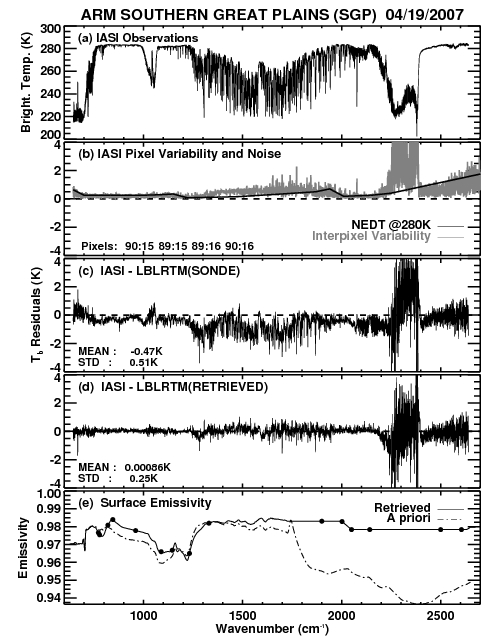

the Voigt line shape, computed with an algorithm based on a linear combination of approximating functions, is calculated at all atmospheric levels and provides the foundation for the LBLRTM line shape modifications to the Voigt are implemented as needed (e.g. line coupling, continuum) based on analyses of laboratory and atmospheric spectra extensively validated against atmospheric radiance spectra from the ultra-violet to the sub-millimeter the self- and foreign-broadened water vapor continuum model, MT_CKD, as well as continua for carbon dioxide; among the other continua included in MT_CKD are the collision induced bands of oxygen at 1600 cm-1 and nitrogen at 2350 cm-1 HITRAN line database parameters are used including the pressure shift coefficient, the halfwidth temperature dependence and the coefficient for the self-broadening of water vapor a Total Internal Partition Function (TIPS) program is used for the temperature dependence of the line intensities CO2 line coupling is treated as first order with the coefficients for carbon dioxide generated from the code of Niro et al. (2005) and Lamouroux et al. (2010); CH4 line parameters include line coupling parameters for the v3 (3000 cm-1) and v4 (1300 cm-1) bands of the main isotopologue temperature dependent cross section data such as those available with the HITRAN database may be used to treat the absorption due to heavy molecules, e.g. the halocarbons an algorithm is implemented for the treatment of the variation of the Planck function within a vertically inhomogeneous layer as discussed in Clough et al. (1992) algorithmic accuracy of LBLRTM is approximately 0.5% and the errors associated with the computational procedures are of the order of five times less than those associated with the line parameters so that the limiting error is that attributable to the line parameters and the line shape computational efficiency mitigates the computational burden of the line-by-line flux and cooling rate calculation [Clough et al., 1992], for example linear algebraic operations are used extensively in the computationally intensive parts of LBLRTM so that vectorization is particularly effective with a typical vectorized acceleration of 20 FFT instrument function with a choice of 9 apodization functions includes a realistic spectral sea surface emissivity model in the infrared [Masuda, et. al., 1988, Wu and Smith, 1997] input atmospheric profiles in either altitude or pressure coordinates interfaces with other radiative transfer models (like RRTM), and as the forward model for inversion algorithms (e.g. Tropospheric Emission Spectrometer (TES) and Infrared Atmospheric Sounding Interferometer (IASI))
LBLRTM inputs are obtained by running the LNFL program with a line file database for the spectral lines and cross sections for the heavy molecules. LBLRTM solar inputs are obtained by running the solar source function program.